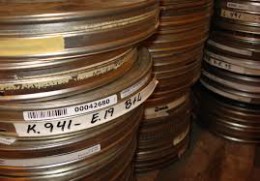Preserving the Future
Part of the appeal of the performing arts is its quintessential ephemerality: performances exist in a particular time and place, in conjunction with a specific group of spectators. The audience is a fundamental element of the performance itself – ask any performer how they play off audience members. A colleague in Arizona named her company the Invisible Theatre to quantify this special – and unseen – relationship.
For better or worse – many artists create work without the foresight or expectation that it will ever be seen again. Needless to say – this behavior of creating work in the moment ultimately challenges and frustrates the work of librarians and archivists trying to document it. And – though no one readily wants to admit this – it actually sets us up for failure.
What is left of a theatrical performance? The script or text, of course [if one exists], production notes from the director and stage manager, scenic and costume designs, lighting plots, production photos, press files, critical reviews. Admittedly – this is meager representation of a three-dimensional, living and breathing work existing in real time. Of course the performance itself lives on in the minds and bodies of the performers – and the memories of audience members. It is embodied – which is why original choreographers and performers can be called upon to reconstruct dances in later years.
A number of experts even object to the term performance reconstruction. When Theatre Library Association organized a Symposium addressing these issues in 2007 – we used an alternative term, reclamation, which we found more suitable to our inquiry and investigation. In actuality – the notion of reconstructing a performance is counterintuitive since it is not an ossified museum piece, but exists in a specific place and time, as well as social and historical context. An example would be the premiere of Brecht and Weill’s Threepenny Opera in 1928 Berlin, restaged with Lotte Lenya in 1954 New York City, and then reconsidered for a reunited Berlin in 1990. Is there a definitive, authentic – Ur – Threepenny Opera?
One factor frequently overlooked in restaging is the influence of interpretation: works unavoidably and fortuitously have different resonances for different times. Is Shakespeare’s The Tempest a parable about an exiled duke whose power has been usurped set on an imaginary island in the New World – or is it about colonial conquest and subjugation of native peoples by hostile invaders?
While it’s been posited that videotaping a performance is ultimately the best record of it – it can only, at best, function as a surrogate representation: an image of Plato’s Cave, but not the Cave itself. Choreographers extensively employ video to document rehearsals, dance segments, and the actual performance itself. However, this is still a two-dimensional, frequently black-and-white, medium to capture the corporeal: work made in time and space by sentient, sweating human beings.
Nevertheless, we’ve recently been treated to high quality, commercial renditions of HD operas and productions from the UK’s National Theatre, artistic products in themselves, but separate entities from their originals. This said: we must be grateful for New York Public Library’s Theater on Film and Tape for their straight documentations of live theatre and dance productions, many of which would have been lost to history. This treasure trove gives us the opportunity to see Charles Ludlam in his extraordinary Irma Vep, while we can regret never seeing Laurette Taylor in her legendary performance in The Glass Menagerie.
Ironically, all of those stockpiled dance documentation Umatic and VHS tapes from the 1970s and 1980s become the preservation nightmare of today’s archivists. When these formats were first introduced, media artists immediately adopted and repurposed them for their own expression. They weren’t thinking of format obsolescence, proprietary software, migration, refreshing, compression, geographic separation of masters. When investigating migration of media, we determine it is variable, multi-purpose, and perhaps best analyzed by its behavior.
A number of museums have created emulation exhibits where original media works are recreated using current technologies. I’ve never quite understood all the time and effort involved in this exercise since artists evolve, their concepts of previous works change, and many continue to tinker with their repertory as they move forward. What is impressive is when installations are recreated and artists are insistent on using the original – if outmoded – technologies. They want to see and hear the slide projectors, the sound of film projectors running and hitting splices that is part of the texture and atmosphere of the piece.
It’s disturbing that a number of our major museums [who should know better] transfer artists’ original films to videotape to facilitate screening, re-edit artists’ works without their oversight or approval. These interventions constitute enormous ethical violation. The artist must be front and center in any restaging of her work. Increasingly, media artists are creating specific instructions and extensive documentation – recording space dimensions, lighting, signage – to assist institutions in appropriate and respectful exhibition practices.
For these reasons, artists must be mindful of their legacies. Organizations such as Independent Media Arts Preservation can partner with practitioners to demonstrate and reinforce best practices such as instituting archival techniques [file naming conventions, etc.] as works are created. Artists should be empowered to follow basic preservation guidelines in addressing their own work. Lastly, artists should be able to make the determination whether they want their work to survive – or if certain pieces can have a shelf-life, then self-destruct. This accords with the right to be forgotten – which proves an ethical dilemma for survivors. What would have happened if Kafka’s heirs had followed his explicit instructions to burn all his writings?
Kenneth Schlesinger, Chief Librarian of Lehman College, is past President of Theatre Library Association and President of Independent Media Arts Preservation. He edited a collection of essays for Performing Arts Resources, State of the Profession: Performing Arts Librarianship in the 21st Century.

